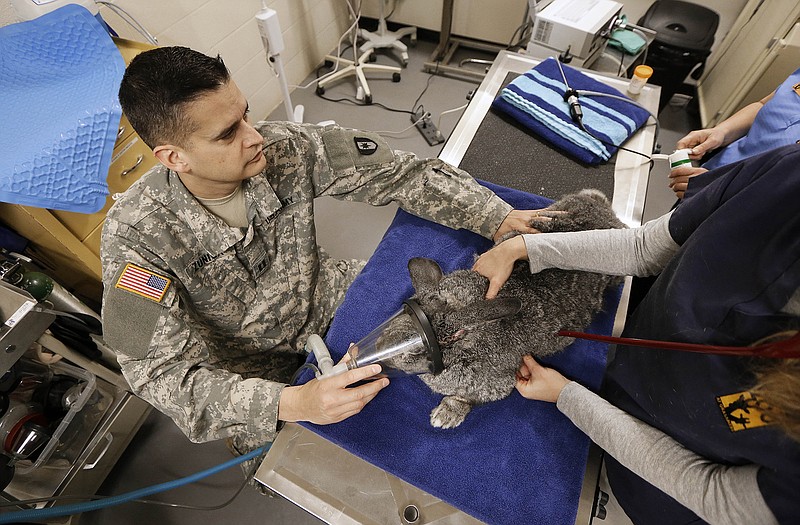NASHVILLE, Tenn. (AP) - At home in Fort Campbell, Army veterinarians mostly treat military working dogs and family pets. But once deployed, they could be called upon to treat just about anything.
It could be camels or livestock or even lions and tigers, as some Army veterinarians discovered during the war in Iraq when they were brought in to help rebuild the devastated Baghdad Zoo.
In order to be ready for whatever is thrown at them, Fort Campbell veterinarians and techs are improving their skills by going on rounds at the Nashville Zoo. It's about an hour from the base, which straddles the Kentucky-Tennessee border.
A recent Wednesday found Capt. Eric Zuniga and Maj. Renee Krebs huddled around a radiograph of the tiny lungs of a hedgehog named Lady. She had A.D.R., Zuniga said, explaining that the acronym is short for "Ain't Doin' Right," a common complaint among the pets they deal with at the Fort Campbell veterinary clinic.
Getting the radiograph required sedating Lady by placing a tiny conical mask over her nose through which she breathed in anesthetic gas.
Once she was under sedation, she was rolled onto her side, exposing her pink belly. An oxygen sensor was clipped to her leg and a hot water bottle and microwaved bag of dry rice were placed next to her to keep her body temperature up.
The vets also collected blood from a vein in her front leg but were not able to get enough for testing.
Diagnosis uncertain.
Other cases were more straight-forward. A baby alpaca needed to be vaccinated. A pregnant giraffe needed a checkup. Without going into detail, let's just say this involved a sleeve-length plastic glove and lubricant.
Zuniga first came up with the idea of partnering with the zoo. Now, most Wednesdays find Zuniga, Krebs, and other members of their unit making the drive from the sprawling Army base to work with zoo veterinarian Heather Robertson.
"Our guys love to come here. ... They've worked with red river hogs, giraffes, performed surgery on a lizard. You never know what you're going to get here, other than it's probably something you've never done in your life."
Army veterinarians care for the working animals in all branches of the federal government.
That can include dolphins, horses and falcons, but most of the time it is dogs. All that canine medicine does not prepare them for the times when they are confronted with animals whose anatomy and biology are totally different.
Erin McLoughlin, who is no longer in the Army, was one of the veterinary technicians who found herself at the Baghdad Zoo in 2004.
Army vets have to "expect the unexpected and make do with what you have," she said.
On one occasion, she helped remove a tumor from a bear. Someone was filming the operation, and the light of the camera illuminated the surgery. Then blood spurted out, and the light went away.
"I looked around, and the person with the camera had passed out," she said.
Zuniga has his own bear story. One wandered into housing when he was stationed at Fort Carson in Colorado. Suddenly, he was expected to be a bear expert.
"This is invaluable training," Zuniga said. "It's great to learn even a little bit about the oddball species you never think you are going to see."

